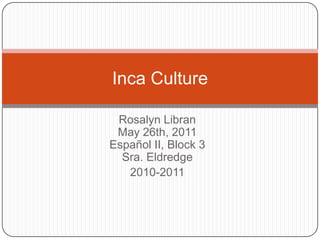
Inca culture rosalyn
- 1. Rosalyn LibranMay 26th, 2011Español II, Block 3Sra. Eldredge 2010-2011 Inca Culture
- 2. The Inca The empire expanded in the year 1438. The Incan empire expanded along the Andes; coming to include parts of Ecuador, Argentina, Bolivia, Chile, and Colombia. The empire grew to be 2,500 miles long, 500 miles wide, and home to 12 million people.
- 3. Geography The Incan empire expanded along the western coast of South America. The empire itself could’ve been divided into three geographical sections, mountain, jungle, and desert. The Andes Mountains separated the empire. The Incans built bridges across the mountain gorges to reach each portion of the empire easily. On one side of the mountain range is the Amazon rain forest and on the other side, along the coast, were deserts. If enemies tried to access certain territory, the Inca simply burned the bridges to stop their progress.
- 4. Language The official language of the Incan people was Quechua. The Inca referred to their empire as TawantinSuyu, which means “The Four Regions”. The original form of Quechua was formed in Cusco, the empire’s capital. There had been no written form of the language so other means of communication was used, such as ceramics, quipus (threaded knots made of llama hair), and spoken Quechua.
- 5. Religion For the Inca there were many forms of worship. It was encouraged to worship the sun god, Inti. The King was often called Sapa Inca, or child of the sun. There was an Incan moral code of; “Do not steal, do not lie, do not be lazy”. Those who followed the code went to feel the sun’s warmth, while the others had to endure the rest of their days facing the earth’s coldness. The Inca also believed in reincarnation. Though they tolerated the religious beliefs of those that were conquered, they required tribute to certain Gods.
- 6. Government The Sapa Inca ruled all. He created his governmental pyramid. This consisted of a Supreme Council of 4 men, provincial governors, officials; that included priests, judges, army officers, and nobles. The pyramid also consisted of tax collectors and at the very bottom were the workers. The tax collectors were in charge of up to ten families or ayllus. When the Sapa Inca passed a law the tax collectors were told to tell the ayllus. If a law were to be broken punishment was brutal as well as quick. At the birth of the royal children, the children’s heads were wrapped in a tight cloth to make their soft skulls conical, boards were then strapped to their heads. Pointed heads signified a high social rank as well as beauty.
- 7. Social Levels The social levels were like many empires of the time. First came the Sapa Inca, nobles (priests, government officials, and relatives of the Sapa Inca), craftsmen and architects (who were needed to build within the empire), common working class, and at the lowly bottom were the slaves and peasants. Most commoners were farmers, though the land was owned by the emperor. Common people were not allowed to own or run a business, own luxury goods or travel on the roads. They were allowed to own the items that pertained to their job. An inspector saw to that these things were done, if the laws were broken the punishment was death.
- 8. Agriculture Since most of the working class were farmers, the Inca were excellent farmers. They would freeze the food, stomp out the water, then leave it in the sun to dry. The food was then stored in warehouses, when it was needed simply adding water worked. The Inca were also responsible for inventing terrace farming and using an irrigation system. Flat land was carved into steps on the side of mountains for farming. The terraces prevented water from running off as well as helped in the reduction of erosion.
- 9. Architecture The Incan cities were beautifully built. Builders constructed their buildings to last long and withstand the threat of natural disasters such as earthquakes. One of the Incas’ greatest form of architecture is Machu Picchu. Machu Picchu is located in Peru, northwest of Cusco and is often referred to as “The Lost City of the Inca”. It was built with traditional stone walls, included buildings for worship, and terrace farming was used to provide food. This was an estate for the emperor Pachacuti.
- 10. Contributions to Society, Math and Science The main contributions to society were their architecture. A calendar was created, like our calendar the Incan one was divided into 12 months. Each month had 3 weeks that consisted of 10 days. The Inca also created a system of measurement and a way of communicating using a system of knots and the number 10. It was believed the Inca told stories using the quipus string.